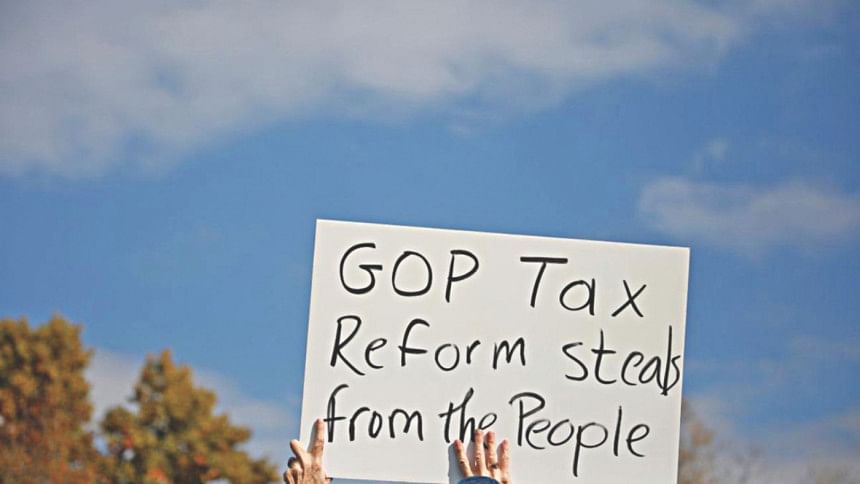The Trump tax cut: A mockery of fiscal responsibility?

It is well known that President Trump's much-ballyhooed recent tax cuts will have a major negative impact on the US federal budget, and according to some estimates, will lead to a USD 1.5 trillion increase in national debt. The cost of this policy will be borne by current taxpayers, but the major burden will rest on future generations. In a nutshell, the tax cuts that the Republicans passed in December will line the coffers of major corporations and bring some short-run tax relief for some American families, but the long-term legacy of this measure will be increased fiscal burden on the average taxpayer.
So, while the president is enjoying a boost in his popularity and the Republicans are hoping to gain in this year's mid-term elections in November, a majority of Americans will be paying for generations for this temporary largesse, in terms of increased debt payment and possible cuts in social safety nets, including welfare payments for the poor, Social Security for the retirees, and Medicare and Medicaid for the seniors. It needs to be seen whether President Trumps keeps his campaign promise to protect these programmes from any cuts.
Coming back to the economic impact, according to the Peterson Foundation, an independent think tank based in Washington, net interest costs for debt servicing will triple over the next 10 years, soaring from USD 269 billion in 2017 to USD 818 billion in 2027, and totalling USD 5.6 trillion over the period. By that time, Donald Trump will be out of the White House and the next presidents will have a major fiscal mess on their lap. To paraphrase Prof Alan Blinder of Princeton, the Republican tax bill demonstrates an utter lack of fiscal responsibility.
As I indicated in previous op-eds in this newspaper (December 16, 2017 and November 25, 2017), estimates of the impact of this tax cuts on the budget, GDP, and the debt burden diverge considerably depending on whether you are a Trump supporter or not. With the tax bill now in effect, we can clearly see that the tax cut is not "paid for," as claimed by the Republicans. The six- or seven-year tax break comes at the cost of an increase in national debt to the tune of 1.4 to 1.6 trillion over 10 years. A new analysis by economists at the University of Pennsylvania's Wharton School, taking into account the bill's effects on the economy and the interest burden from higher debt levels, estimates that "it would add roughly USD 3 trillion to the debt between 2028 and 2037, the next decade beyond the current ten-year budget window."
While tax cuts are popular and at times necessary to stimulate the economy, many well-known economists and even the Wall Street Journal, which speaks for the business community, have raised concerns about the timing of Trump's measures. The latest tax cuts have frequently been compared to the last major ones during Presidents Reagan and George W Bush's first years in office, in 1981 and 2001 respectively. However, there are two key differences between then and now. Federal revenues have dropped from 19.1 percent to 17.3 percent between 1981 and 2017, and the federal debt as a percentage of GDP has skyrocketed from 25.2 percent in 1981 to 76.7 percent in 2017, according to the non-partisan Congressional Budget Office. The annual deficit for fiscal 2017 was USD 666 billion, or 3.5 percent of the overall US economy, and will jump to over a USD 1 trillion by the end of 2020. Thus, the tax cuts are not revenue neutral as has been claimed, based on GDP growth projections.
When fully implemented, the tax cuts would increase the size of the economy above current projections by between 0.4 percent and 0.9 percent by 2027—meaning it would only add between 0.04 percent and 0.1 percent to economic growth each year, on average. Further, the Penn Wharton study concludes that "this initial boost fades over time as more debt accumulates." Even after taking GDP growth into account, the study finds the bill would add roughly USD 3 trillion to the debt in the next ten-year period (2028-2037).
Many of Trump's detractors are correctly taking him to task for mortgaging the future for temporary gains in poll numbers. This is an election year. With 34 seats in the Senate, and all 435 in the House up for grabs, the Republicans will try to keep control of Congress. History tells us that mid-term elections have been harsh to the party of the president. In other words, voters may punish the party in power in the White House. Presidents Clinton, George W Bush and Obama faced the tune. Therefore, the Republicans are aware that they stand to lose the majority.
Until now, President Trump has not been able to achieve any of his major goals. True, the economy is in a boom, unemployment is low, and the stock market is roaring. However, President Trump can hardly take exclusive credit for the growth in GDP and employment. As for stock market, yes, since November 8, 2016, major stocks have been on an upward path, but it had been growing since Obama's times. Admittedly, President Trump can take credit for promising investment in infrastructure and easing some regulatory enforcement, and his "America First" talk. It is not far-fetched to call Trump's tax cuts an attempt to fool the public. Republicans can claim that with taxes reduced, take-home pay has increased, and some firms are even sharing their largesse, giving employees one-time bonuses "in a high-profile effort to show that the bounty for businesses is trickling down."
Ironically, in 2009, when Obama proposed a tax cut to stimulate the economy, Republicans opposed it arguing that the tax cut was not paid for and would increase the deficit. This line was in direct contradiction to their earlier assertion, known as "supply side theory," that tax cuts increase government revenue since economic growth stimulated from tax cuts leads to more income and more tax revenue.
On February 1, the Wall Street Journal, a Republican bastion, reported that the tax cuts have already led to a tightening credit market. The previous day, in an op-ed titled "Why Now is the Wrong Time to Increase the Deficit," Alan Blinder elucidates the theoretical reasoning for this market trend. It is estimated that the Treasury Department would need to borrow USD 955 billion in the fiscal year that ends in September 2018, an increase in USD 434 billion from last year. This would climb to USD 1.083 in 2019 and USD 1.128 trillion in 2020. While borrowing by the Treasury is not uncommon, the current acceleration is the first since the recession in 2007-09, when interest rates were low and global inflation was very modest. According to the Treasury Borrowing Advisory Committee or TBAC, a group of private banks that advise the US government, the tax-cut driven round of borrowing is certain to put upward pressure on interest rates and inflation tendencies, given that the US and global economy is on a path to sustained growth in 2016-2020. The signs are already there: "yields on 10-year Treasury notes rose 3.13 percentage points in January to 2.722 percent and are up 0.664 percentage point since September."
While US government borrowing is low by global standards, it cannot be gainsaid that budget deficit will go up and so will national debt. Unless growth in GDP leads to higher revenue in absolute terms, as predicted by the Supply Siders, the impact on taxpayers will be significant in the future. Unfortunately, we can only wait and see, but as Keynes once said, "in the long run, we are all dead."
Dr Abdullah Shibli is an economist and Senior Research Fellow at International Sustainable Development Institute (ISDI), a think-tank based in Boston, USA.





Comments